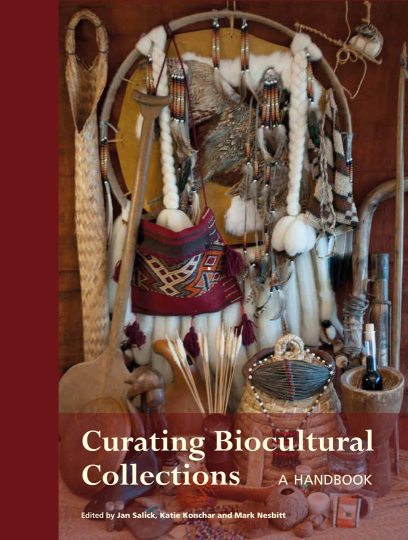Curating Biocultural Collections: A Handbook
Editors: Jan Salick, Katie Konchar, Mark Nesbitt. 254 pages. 253x190mm. 100+ colour photographs. Paperback, ISBN 9781842464984, Kew Publishing in association with Missouri Botanical Garden Press 2014.
The first major curation manual for biocultural collections, filling a longstanding and real need. Chapters cover curation of material collections including herbarium, ethnozoological, paleo- ethnobotanical , xylarium, ethnographic, ethnobiological products, DNA, horticultural, and seed collections; the curation of related reference collections including databases, books and archives, photographs and images, linguistic and audio information, and ethnographic information.
The authors use real-life case studies and a carefully-chosen bibliography, with many references to online resources. This book demonstrates the central importance of such collections for research, and draws on a wide range of expertise and case studies to show how they should be cared for. Throughout there is a strong emphasis on meeting the needs of collection users, and for ethical and equitable engagement with source communities.
Winner Postgraduate Textbook Prize at the Royal Society of Biology book awards, 2015
The judges said: A stunningly visual and engaging book with a crisp, clear and example rich style. It captivates the reader with its breadth of topics and range of examples, case studies and photographs.
Finalist, Mary W. Klinger Book Award, Society for Economic Botany
Bradley Bennett, Chair of the Award Committee, described the book as: an essential reference for researchers working with biocultural collections... I especially appreciated the breadth of coverage in that category.
Media Reviews:
I recommend this book to anyone working in a museum that holds either natural history (especially zoology or botany), archaeological, or anthropological collections. It offers a fresh way of thinking about potential implications and uses for such collections, in a more holistic way than is often achieved in multidisciplinary museums. Henry McGhie, Manchester Museum
I would recommend this book to a museum that holds ethnographic collections, and a bonus if it also holds natural history collections. The book can be used by both areas to help safeguard the collections for the future. It is a Handbook which can be used if you are undertaking a specific collections project or if you updating your database. Clearly laid out with nice images the chapters make available the most up to date information on that area.
The book provides a really useful guide to caring for a diverse range of collections many of which a natural history curator cares for too. As there is a lot of cross over, the book can also develop a stronger understanding between departments about the objects and specimens they care for; a better understanding of other curators collections will lead to greater working relationships. Jan Freedman, Plymouth City Museum and Art Gallery
I think Curating Biocultural Collections A HANDBOOK is a very useful reference resource for managing a diverse array of collections and seeking guidance on curation and care of these collections. It will soon become one of those ‘classic’ reference books for many of us working in botanic gardens. Lucy Sutherland, The Botanic Gardener
This handbook on the curation of biocultural collections is admirable... a valuable asset to museum curators, educators, and professionals who deal with the collection of biocultural specimens or who prepare and submit specimens for curation. Pamela J. McBride, Museum Anthropology
Jan Salick is Senior Curator at Missouri Botanical Garden and has helped lead ethnobotany to become a quantitative science, international in scope and active in global policy. Katie Konchar is a biologist and botanist with a M.S. degree from the University of Wisconsin-Madison. Mark Nesbitt is curator of the Economic Botany Collection at the Royal Botanic Gardens, Kew, and his research interests centre on botany and empire in the nineteenth century, and on the history and current day management of botanical collections.
| Product type | Books |
|---|
United Kingdom
We offer FREE delivery on UK-only orders over £50 (Tracked Standard delivery service). (This does not apply to our print-on-demand service)
Our other delivery costs are as follows:
-
UK Tracked Standard - £5 (delivery 3-6 working days from date of order)
-
UK Tracked Express - £8.95 (delivery 1-3 working days from date of order)
Please note the following exclusions:
Mat Collishaw framed prints can take up to 2 weeks for delivery and are excluded from promotional discounts.
We are unable to deliver to hotels and PO BOX addresses. In the event that an order is placed to be delivered to either of these destinations, we will cancel and refund the order.
Last posting dates guaranteed for Christmas 2024
UK orders
- 16th December for standard delivery shipping
- 19th December at 12pm for express delivery shipping
International orders
- 5th December for all Countries
Age restricted products
If your basket contains age restricted products, our courier will request passport or driving license ID if the recipient looks under 25.
Pre-orders
If your delivery contains an item on pre-order then we will wait for the full order to be assembled before we dispatch, unless stated otherwise on the pre-order product page.
International and EU
International and EU orders are subject to variable postage costs calculated at checkout; these are dependent on the size and value of your order.
Orders to EU and International addresses may be subject to local customs duty or taxes. You will need to pay any additional charges for customs clearance, charges include local VAT and duty based on the value and origin of the product upon receipt of your order.
Weight restrictions: We are unable to ship orders where the total weight is over 2kg outside of the United Kingdom.
Product restrictions: We are unable to ship seeds, plants, bulbs, inflammable products, sharp and/or bladed items, food and beverages outside of the United Kingdom.

